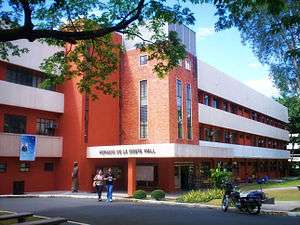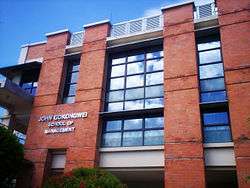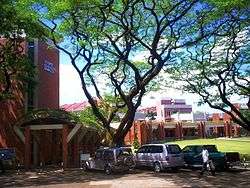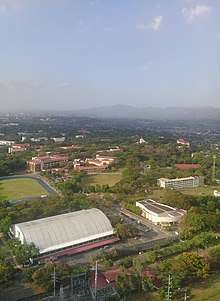Loyola Schools
The Loyola Schools is the college unit of Ateneo de Manila University, a private Catholic research university in Quezon City, Philippines, run by the Jesuits. It is a group of four schools that offer undergraduate and graduate degree programs in the arts and sciences. It is located at the university's Loyola Heights campus in Quezon City.
Mga Paaralang Loyola ng Pamantasang Ateneo de Manila | |
| Established | 2000 |
|---|---|
| President | Fr. Jose Ramon T. Villarin, S.J., Ph.D. |
| Vice-president | Ma. Luz C. Vilches, Ph.D. |
| Location | , , |
| Campus | Urban |
| Colors | Blue and White[1] |
| Website | http://www.ateneo.edu/ls |
The Loyola Schools offer Bachelor of Arts (AB), Bachelor of Science (BS), and Bachelor of Fine Arts (BFA) degrees at the undergraduate level, and Master of Arts (MA), Master of Science (MS), and Doctorate degrees at the graduate level.
Structure
The Loyola Schools is a group of four schools: the Schools of Humanities, Science and Engineering, Social Sciences, and the John Gokongwei School of Management. The four schools house all of Ateneo de Manila's undergraduate, and a majority of its graduate, programs. The group is managed as one unit, led by the Vice President for the Loyola Schools; each school, in turn, is led by a Dean, who in turn oversees the department chairpersons and program directors.[2]
The unit traces its roots to the School of Arts and Sciences, which was restructured into the four Loyola Schools in 2000.
School of Humanities

Dean: Jonathan Chua, Ph.D.
- Department of English
- Department of Filipino / Kagawarán ng Filipino
- Department of Interdisciplinary Studies
- Department of Modern Languages
- Department of Philosophy
- Department of Theology
- Department of Fine Arts
- Theology and Ministry Program
John Gokongwei School of Management

Dean: Luis F. Dumlao, Ph.D.
- Department of Finance & Accounting
- Department of Leadership & Strategy
- Department of Marketing & Law
- Department of Quantitative Methods & Information Technology
School of Science and Engineering

Dean: Evangeline Bautista, Ph.D.
- Department of Biology
- Department of Chemistry
- Department of Environmental Science
- Department of Information Systems & Computer Science
- Department of Mathematics
- Department of Physics
- Department of Electronics, Computer, & Communications Engineering
- Health Sciences Program
School of Social Sciences
Dean: Fernando Aldaba, Ph.D.

- Chinese Studies Program
- Department of Communication
- Department of Economics
- Department of Education
- Department of History
- Department of Political Science
- Department of Psychology
- Department of Sociology & Anthropology
- Development Studies Program
- European Studies Program
- Japanese Studies Program
Academics
As of academic year 2019-2020, there are a total of 92 graduate[3] and 48 undergraduate[4] concentrations on offer by the Loyola Schools. Undergraduate students also have the option of taking minor concentrations from any of the four schools.
Aside from their major and minor fields of concentration, all undergraduate students must take the core curriculum of English and Filipino language and literature, foreign language (Spanish, Russian, German, Portuguese, French, Italian, Latin, Bahasa Indonesia, Mandarin, Korean, and Japanese are currently offered), mathematics, natural sciences, sociology and psychology, political science, and history, along with philosophy and theology as the centerpiece.
Student-centered learning
The Ateneo de Manila's teaching methods are geared toward student-centered learning. Loyola Schools faculty are prepared for their role by the Loyola Schools' Teacher Formation Institute. Teaching materials and methods foster student participation, individual and group projects, mentoring, and other activities that vie with coursework for importance. Professors offer students individual help in their area of interest. All faculty are evaluated by students each semester, and there are annual faculty activity reports and faculty peer evaluations.
Centers of Excellence & Development for Excellence
Centers of Excellence (COEs) and Centers of Development (CODs) are programs identified by the Philippine Commission on Higher Education (CHED) as exhibiting the highest standards of instruction, research, and extension. Such programs are expected to provide leadership and networking arrangements to ensure the accelerated development of all the schools. The COEs/CODs are given funding assistance for student scholarships, faculty development, library and laboratory upgrading, research and extension services, instructional materials development, and networking among existing COEs and CODs. As of May 2017, the programs included:[5]
|
Centers of Excellence
|
Centers of Development
|
Research
Aside from teaching, the Loyola Schools engages in research work through various research units within the Loyola Schools and with other units of the Ateneo de Manila University. Faculty are given incentives by the Loyola Schools and other grant-giving organizations.
Scholarly publications
Among the scholarly publications published by the Loyola Schools are:
- The Loyola Schools Review - each volume contains four books, bearing as subtitles the names of the four schools. It is published by the Office of Research and Publications and distributed in the Philippines, Asia, Europe, and America.
- Budhi - the Loyola Schools interdisciplinary journal of ideas and culture focusing especially with a focus on the humanities and social sciences. It is published by the Ateneo de Manila University Press and distributed worldwide.
- Kritika Kultura - an electronic journal of literary, cultural, and language studies. It is published by the Department of English, School of Humanities and focuses on issues relevant to the 21st century.
- Philippine Studies - technically not published by the Loyola Schools but by the whole university, this periodical is an internationally refereed journal containing a wide variety of scholarly and original articles by both young and established scholars. Past editors-in-chief include Fr. Horacio de la Costa, S.J. and Fr. Roque Ferriols, S.J. It is published by the Ateneo de Manila University Press.
Student research and creative work
Students also engage in research and creative work as part of academics and extracurriculars. Student research publications include:
- The Ateneo Student Business Review - A research journal published by students of the John Gokongwei School of Management, focusing on the local and international business environment, entrepreneurship, as well as business research and business plans by students of the JGSOM.
- The Ateneo Student Review for the Social Sciences - A research journal published by students of the School of Social Sciences, focusing on social, political, and economic issues.
- Pilosopo Tasyo - The official scholarly publication of the Samahan ng Pilosopiya ng Ateneo de Manila, focusing on student work in philosophy.
The School of Science and Engineering confers awards for student research, science writing, photography, and science-related creative work.
Student news and creative publications are organized into the Council of Publications and include:
- The GUIDON, a monthly newspaper in English, covering both Ateneo news and issues outside the campus
- Matanglawin, a quarterly magazine in Filipino, featuring investigative journalism about Ateneo and national issues
- Heights, an official literary publication, published in both English and Filipino
- Aegis, the senior yearbook, released every March.
The Loyola Schools Awards for the Arts recognizes outstanding work by graduating students in the following categories: creative writing (fiction, poetry, drama, essay), dance, graphic design, music, photography, screen arts, theater arts, and visual arts. There is also a Fine Arts Festival held by the students in the Fine Arts Program, featuring original plays, multimedia exhibits, and readings of literary works. There are also the Raul Locsin Awards for Student Journalism.
Ateneo research centers and facilities
|
|
Administration and Student Services
Under the Vice President are the administrative and student service offices that serve all the four schools.
|
Associate Deans
|
Offices under ADSAS
|
Office under ADSF
|
Other Administrative Offices/Units
|
Campus

The Loyola Schools are located in Ateneo's main campus in Loyola Heights, Quezon City; it occupies the middle portion of the campus. The arrangement of the Loyola Schools academic buildings reflects their origin as a single School of Arts and Sciences.
College Quad

The "College Quad" is bounded by the first three academic halls, Kostka, Gonzaga, and Berchmans. Kostka houses the Office of Admission and Aid; Gonzaga contains the cafeteria, fine arts program, and Immaculate Conception Chapel; Berchmans hosts the placement and guidance offices. Both Kostka and Berchmans have classrooms that are shared by the schools of Humanities and Social Sciences. Xavier Hall is home to the Vice President for the Loyola Schools and university central administration offices.
College Lane
Along College Lane of the central campus lie: the old Rizal Library building, with Special Collections and the Ateneo Art Gallery, and its Annex housing the Archives and Rizal Mini-Theater; Schmitt Hall, home to the Department of Chemistry; the Manuel V. Pangilinan Center for Student Leadership (on the former site of Colayco Hall) which houses student organizations and the bookstore, and Colayco Pavilion; the Social Sciences Building, home of the Registrar and of the psychology and communications departments; De La Costa Hall, home of the School of Humanities; and Faura Hall home to physics, computer science, engineering, and the Philippine Institute of Pure and Applied Chemistry.
Science Education Complex
Beyond College Lane is the Science Education Complex composed of three buildings, each housing classrooms, large lecture halls, and science laboratories. The SEC is also home to the office of the dean of the School of Science and Engineering, the departments of mathematics and biology, and the health sciences program. Specialized facilities include a small collection of stuffed, preserved animals and a greenhouse. The SEC was built in 1997 as part of an aggressive expansion program, with architecture that coheres with the old Ateneo Municipal in Intramuros.
Joining the SEC via a covered walk, and cohering in architecture, are the PLDT Convergent Technologies Center, with classrooms and labs for engineering students, and the John Gokongwei School of Management, with the Ching Tan Lecture Room and JGSOM faculty offices. The quadrangle formed by the SEC covered walk and College Lane hosts student fundraisers, sportsfests, and cultural activities.
An outer circle beyond these buildings contains Matteo Ricci Study Hall, JGSOM Student Enterprise Center, and Eagles' Park (a mini-arboretum).
Father Masterson Drive
Along Father Masterson Drive, the road linking Blue Eagle Gym, the grade school, Loyola Schools, and the high school, lie the Manila Observatory which hosts the Department of Environmental Science; the former Communications Department building; the physical education department, tennis courts, shooting range, and covered courts.
Residence halls & Church of the Gesu
Further down Father Masterson Drive are Alingal Hall, the Cervini-Eliazo Residence Halls (dormitories for men and women), the University Dormitory, the Church of the Gesu, and the John Pollock Renewal Center which hosts retreats and workshops. The Church of the Gesu holds 1,000 people and features a nineteen-bell carillon. The residence halls look out on the Marikina Valley and the Sierra Madre.
University Avenue
Additional buildings on University Avenue are Leong Hall (faculty center of the School of Social Sciences), the new Rizal Library building, and nearby Bellarmine Hall, a former dormitory which now houses classrooms and the Ateneo de Manila University Press. Bellarmine Field is used for ROTC drills and celebrational bonfires. Also accessible from University Avenue are the Social Development Complex and the Institute for Social Order.
Athletic facilities
The Loyola Schools (College) Covered Courts have seven regulation-sized basketball courts with concrete-floors convertible to futsal, a volleyball court, an exercise gym, showers, and a swimming pool used for classes and varsity practice and team meets. The same complex contains tennis courts, the offices of the physical education department, and a shooting range used by the rifle and pistol varsity team, the first of its kind in the Philippines. Across Father Masterson Drive are a squash court and the Moro Lorenzo and Ocampo varsity soccer fields, which host the UAAP soccer tournament. Beyond the soccer fields is the Blue Eagle Gym. The softball field is located along University Avenue in front of the new Rizal Library building and Leong Hall.
Students
The Ateneo has a robust student community, with almost 80% of the students participating in student organizations and activities. Worth mentioning also are the rights granted to all students by a "Magna Carta" dealing with academics, access to information, freedom of expression, participation in school policy-making, organization, security, and due process (especially in disciplinary proceedings). The Loyola Schools' student council, the Sanggunian ng mga Mag-aaral ng mga Paaralang Loyola ng Ateneo de Manila, or the Loyola Schools Student Council, has a history of active and committed social involvement, but has become more moderate in its stance in recent years.
Council of Organizations of the Ateneo
|
Business Cluster
Faith Formation Cluster
Health and Environment Cluster
Intercultural Relations Cluster
Analysis and Discourse Cluster
|
Media and the Creative Arts Cluster
Performing Arts Cluster
Sector Based Cluster
Science and Technology Cluster
|
Image gallery
- Philippine Jesuit Aid Association, CLC Center
- Pedro Arrupe International Residence
 "Salubong" (by Jose Blanco)
"Salubong" (by Jose Blanco)- Loyola School of Theology
 Loyola School of Theology
Loyola School of Theology- St. Ignatius of Loyola pond
- Spiritual Pastoral Center
References
- "Blue And White". Ateneo de Manila University. Retrieved April 21, 2020.
- Student Handbook 2019 Edition_0.pdf "Graduate Student Handbook 2019" Check
|url=value (help) (PDF). Ateneo de Manila University. Retrieved May 2, 2020. - "Graduate Studies advertisement". Ateneo de Manila University. Retrieved May 2, 2020.
- "Fields of Study". Ateneo de Manila University. Retrieved May 2, 2020.
- "List of Centers of Excellence (COEs) and Centers of Development (CODs)" (PDF). Commission on Higher Education. Retrieved May 2, 2020.
External links
- [http//ateneo.edu/ Ateneo de Manila University website]
- Loyola Schools website